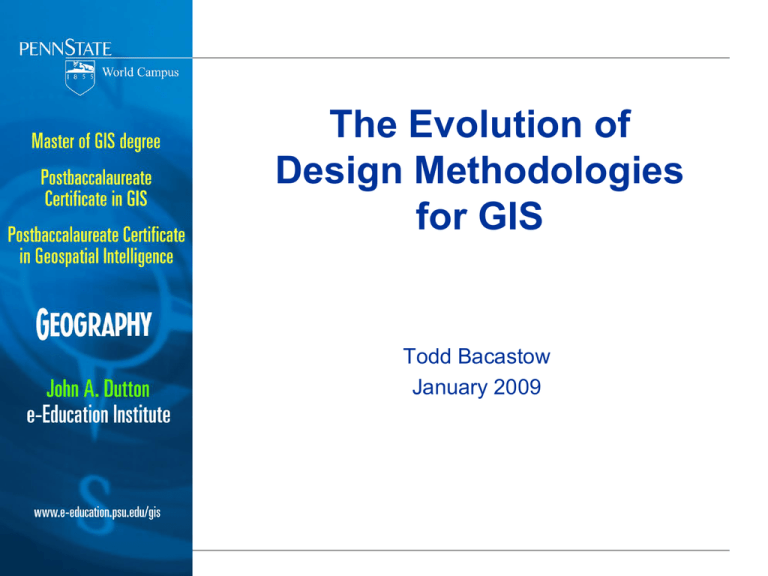Design Methodology specifically for GIS - e
advertisement

The Evolution of Design Methodologies for GIS Todd Bacastow January 2009 Tomlinson 1960s – 1980s Review Requirements Req’t vs Constraints Organization Comments • • • • • Begins with Vision Requirement Driven Linear Req’t vs. Constraints Feedback Calkins 1970s – 1980s Software Analysis and Design Initiation Implementation Performance Hardware Analysis and Design Data Analysis and Design Comments • • • • • Divide Linear Incremental Feedback Stakeholder participation Marble and Wilcox 1991 Marble and Wilcox 1991 Marble and Wilcox 1991 Initiation Implementation Design Analysis Comments • • • • Organizational changes General to the specific Best over the ideal User acceptance Peuquet & Bacastow 1991 Initiation Analysis Design Analysis Design Implementation NYS 1997 Analysis Initiation ?? Implementation Design Comments • Lots of approaches • All have good and bad Lesson 2 Review Questions • Who are the typical stakeholders in a geospatial system? What are their roles? • Explain why a system owner is particular important to a geospatial system? • What are the differences between the role of system analysts and the role of the rest of the stakeholders? Stephanie Potts What kind of knowledge and skills should a system analyst possess? • • In addition to computing knowledge that system analysts should possess, what are the other essential skills that they need to effectively complete their jobs in geospatial system development? • What are the four steps in Whitten’s system development process? How does this compare to Tomlinson? J. Earwood Why is system initiation essential in the system development process? Why do we need to identify the spatial system architecture? • • • • • • • • • • How are the business perspectives and the technology perspectives of a spatial system related? Why is an understanding of the system's functions an essential building block of a geospatial information system? m. beckley What is user’s dialogue? Why has the inherently natural use of the graphical user interface GUI in geospatial systems complicated the design process for system designers? Explain why having a standardized system development process is important to an organization performing spatial activities. How are system life cycle and system development methodology related in spatial system design? What are the 10 underlying principles for systems development? Why are process management and project management necessary? • What is risk management? Is this particularly necessary with geospatial design projects? • Which stakeholders initiate most projects? What is the impetus for most geospatial projects? Who are the main participants in the scope definition in a spatial system? What are their goals in the scope definition? What are the three most important deliverables in scope definition? • • • Who are the main participants in the requirements analysis phase when developing a spatial system? Why are they the main participants? • • What feasibility analyses are made in the decision analysis? What is model-driven development? • • Why is model-driven development popular? Give an example of CASE use in GIS development.











